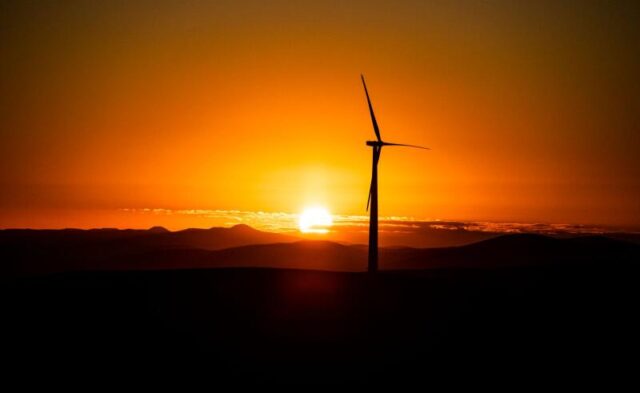The Roggeveld Wind Farm on the border of the Western and Northern Cape provinces, near Sutherland, is producing the most affordable electricity being fed into the national grid in the country.
FORTY-SEVEN giants straddle the border of the Western and Northern Cape provinces. They are not guardians. They are suppliers of one of the country’s most pressing needs, electricity.
The Roggeveld Wind Farm, near Sutherland, is supplying the national grid with the lowest tariff achieved in Round 4 of the Renewable Energy Independent Power Producers’ Procurement Programme (REIPPPP). The Project is owned, in majority, by Red Rocket and AIIM’s Ideas Fund via a holding company (51%). The other shareholders are H1 Holdings (23.25%), the Government Employees Pension Fund (23.25%) managed by the Public Investment Corporation (PIC), and the local communities through the Roggeveld Wind Power Trust (2.5%). It’s producing the most affordable electricity being fed into the national grid in the country.
The Roggeveld Wind Farm was officially inaugurated by the Deputy Minister of Mineral Resources and Energy Dr Nobuhle Nkabane in May 2022 and has an installed capacity of 147MW.
Red Rocket CEO Matteo Brambilla said the company holds as its greatest achievement, beyond achieving the most affordable tariff, the strength of Red Rocket’s domestic talent that was able to bring its ‘Field of Dreams’ to reality.
Constructed at an estimated cost of R4.4 billion, the 47 Nordex wind turbines at the Roggeveld Wind Farm will generate 613GWh per year. The power generated will satisfy the energy needs of 49,200 households while avoiding 502,900 tons of CO 2 per annum.
Nkabane said renewable energy projects, delivered through the government-led programme must meet the intention of the programme to pursue the country’s transformation imperative.
The project committed 1.5% of its revenue to socio-economic development throughout the contract and the department expects that this revenue will create sustainable value for local communities.
“Our programmes, of which we are proud, include the support of a cohort of existing tertiary learners from these communities whom we will be sponsoring,” Brambilla said.
He added that more broadly, the project aims to support community-based health care, food security and water resilience initiatives in the coming years.
Reyburn Hendricks, the CEO of H1 Holdings, a 100% black-owned infrastructure, investment and development company, partnered with Red Rocket on three renewable energy projects, said the partnership will bode well for the energy space.
“Together with Red Rocket, H1 is actively working towards contributing to meeting South Africa’s commitment to a low-carbon energy system,” he said.
As for securing the land on which the turbines stand, land acquisitions manager at Red Rocket Andries du Plessis said it was a matter of knocking on the doors of landowners in the area, asking to lease the land.
“Many landowners initially said no but now many are keen. They have learned that they too can make money in the process. These days we cannot keep track of the requests from landowners to lease their land.”
Five of the turbines are in the Western Cape and the other 42 are in the Northern Cape, although they are not all on the same farm (it spans across five local farms). Asked why the site was chosen, the answer is that it has the best wind resources in the country, measuring annual average wind speeds of above 8m/s.
The facility manager at the wind farm, Nhlakanipho Kunene, said the turbines started producing power commercially on February 26, 2022 and has a 42.03% capacity factor (CF). Each giant tower reaches 100 metres into the heavens. Each turbine blade measures 61.2 metres, almost the equivalent of a Boeing 747’s wingspan of about 68 metres.
The giants are so sophisticated that they are autonomous and can run self-tests or diagnosis and recover themselves on certain categories of safety and stoppage conditions. Human intervention is required around 10% of the time during operation (or during production of electricity). The wind farm is built to boost or reduce its own power as needed by the client (Eskom), and best of all, the concrete towers and substations, are built locally.
“We have three monitoring centres involved with technical services and maintenance management, central monitoring operations (energy production, and grid compliance) and contractual performance and reporting and we can detect changes in the wind turbine statuses and substation in a matter of milliseconds.
“We also have environmental stewards who monitor species of concern around the wind farm. We apply Human Shutdown on Demand on turbines ensuring the main species of concern on site, the Verreaux eagle, is not affected. To date no Verreaux eagles have been killed due to the success of the team undertaking the Human Shutdown on Demand.”
Roggeveld stewards monitoring birds and bats are graduates and postgraduates in the environmental fields and appointed by Terramanzi Group (Pty) Ltd.
The Roggeveld Wind Farm single client (Single Buyer Office), Eskom and Roggeveld Wind Power have a signed 20-year power purchase agreement. And while there are four deadly snakes in the area, the team is happy to report that there have been zero incidents so far.








